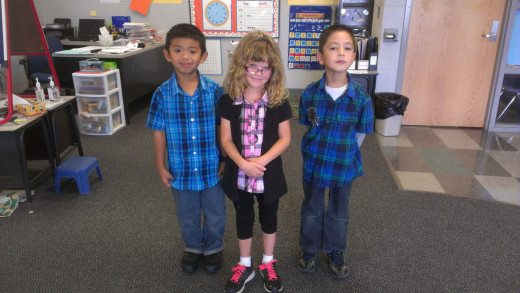How To: Disciplining an Entire Group of Children
Some Of My Little Angels

Before Discipline - Build That Relationship
I have been teaching for fifteen years, more or less. I love my job, and honestly believe that there could be no better job in the world. I love the kids I work with, and absolutely love it when they come back to visit me.
Sometimes these little angels that I work with can be less than angelic. I do what I can to prevent that from happening, but they are children and sometimes children act like children instead of angels. There are many ways to make sure that the children are always (okay…almost always) on their best behavior.
The most important thing you must do at the beginning of every school year is to build connections with your angels. You can build relationships in a variety of ways. The easiest way is to just get to know them. During the first week I usually pass out a questionnaire for the children to fill out. If you are like me and teach special education, you will have to help the students fill this out. On this questionnaire there are questions that ask children about their families – Who lives at their house? Is it mom and dad or is it grandparents? Are there brothers or sisters? Pets? I also ask about their favorite television shows and movies, toys, books and sports teams. I ask all of these questions to help me throughout the school year.
I also let the students get to know me. I let them know that I am a mom and a grandmother and that I have a dog. I talk about my grandchildren, and occasionally bring them to school so that the kids can see them. We talk about when I was their age and how I acted as a child. I let them know that I am just a person that happens to be their teacher.
I use this information to make “deposits” in their emotional “banks.” I can talk to a student about the television shows they watch. I tease them about their sports teams. If I use any worksheets I incorporate their favorite book characters when possible. I encourage them when they tell me they are going to try out for a sport or a part in a play. I watch their classroom music programs. I play their favorite songs in the background as I teach.
I do all of this because my angels are not always angels. Sometimes they talk without raising their hands. Sometimes they tease each other. Sometimes they are late to class or forget to turn in their homework. When this happens, I can make withdrawals from their “bank,” and since I have made so many deposits, they are not left completely drained. I can give them reminders about how I want them to behave and what I expect from them. I let them know that I know that they are awesome kids, and that they know the classroom procedures. Usually, because I have built a relationship with them, they get back to being the great kids I know they can be.
Relationships Are Key Before Disciplining An Entire Group of Children
Remember that you need to build relationships with your students. Make deposits in their emotional banks so that when you have to make withdrawals, you will leave them with something in their banks. Here are some deposits you can make:
- Discover their favorites - movies, songs, games, etc. - and use them as much as you can throughout the year.
- Try to speak with your students before the school year begins - make a visit to the home or call them. It will show the child - and their parents - that they are valuable to you and worth the extra time.
- Take time to joke and tease - it only takes a few minutes and it helps to show your students that you are human.
- Tell your students stories about yourself when you were their age. Tell them about the mistakes you made and how you overcame them. This will also show that you are human.
- Be yourself - you are teaching because you love children. If you don't, then you need to find another job. Don't be afraid to show that you care, and that you can be silly, too.
The Purple Folder For Discipline
Once I have built the relationship, I can use a variety of strategies to help them to be the best they can be. One thing that I have done since I began teaching is what I call the “purple folder.” In my case, this is a purple three pronged pocket folder. Inside is a behavior sheet. It changes depending on the student, the age of the student and the student’s home room teacher. The younger the student the simpler the behavior sheet. Since I only have the students for part of the day, they must carry their purple folders everywhere they go during the day. If they misbehave in their homeroom class, a specials class, during lunch or recess, their behavior is marked in their purple folder. If they don’t misbehave, they get a smiley face or a plus mark. At the end of the day, we had up the smiley faces or plusses and subtract the mis-behaviors. That leaves them with their points for the day. On Fridays they can spend their points in the class store – which I have stocked using items from their questionnaire at the beginning of the year.
The Token Economy for Discipline
Some years I use a token economy. When I work with the older students, I often use checkbooks. Students earn “money” throughout the day which I show by giving tally marks on the whiteboard under their names. At the end of the day, the students count up their tally marks, or “dollars” and record it as a deposit in their checkbooks. At the end of the week, they can use their bank account to buy something from the class store. They must write me a check and deduct the amount spent from their checkbooks. If they misbehave during the day, they must pay a predetermined fine for their behavior. They must write me a check for this, as well. They don’t like having to write checks unless it is for store. I had one student return after he graduated from high school. He had to take an accounting class at school. He came back to tell me that at the beginning of the class, he was the only one in the class that knew how to write a check!
Summary of Discipline Tips For An Entire Group of Children
-
Purple Folder - Used with simple behavior chart with tally marks or smiley faces
-
Token Economy - I use points that we call "dollars" and add and subtract from a checkbook
-
Sticker Charts - Best for younger children who love to collect the stickers
-
Good Book - Simple notebook with only good news written by parents and teachers
-
CIA's - Tickets given to children "caught in the act" of good behavior
The Sticker Chart for Discipline
One of the easiest ways to keep track of discipline issues is a simple sticker chart. When students are behaving as they should, they receive a sticker. Once the sticker chart is full, they can use it to buy a treasure from the class store. Some students get to buy something every few days, while other students take a little longer. This works best for younger students.
The Good Book for Discipline
Something else I sometimes use is a “Good Book.” A Good Book is a spiral notebook that travels between classes, much like the purple folder, but instead of keeping track of the negative behaviors, only positive things are written in it. This book also travels home so that parents or guardians can write about the good things their child does at home. This works particularly well for those students with moderate behavior issues.
Which Would You Use?
Which of these discipline tips do you think you would use after you have built a relationship with your students?
CIA's for Discipline
At our school, we give out “CIA’s” or Caught in the Act tickets. When a child is caught doing something good, he or she can get a CIA. These CIA’s are then turned into a bucket or bag in the classroom. Depending on the teacher, these tickets are then drawn out daily or weekly and the student whose ticket was drawn receives a small prize. This prize can be from a class store, a free homework pass, a chance to sit with the teacher at lunch or anything else the teacher desires. Once a week a CIA is chosen and that student gets to go get a treat from the principal.
These are just some of the strategies I use to keep discipline in the classroom. I have used others in the past that have worked, as well, but these are the easier ones to implement. As I said at the beginning, though, none of these strategies will work until you have built a positive relationship with the students you teach.








